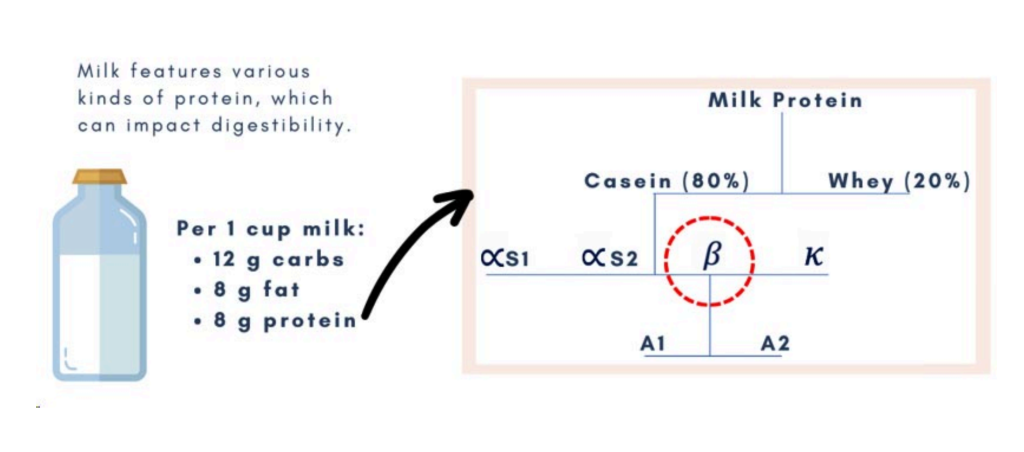Dairy products are superfoods! They provide an array of essential vitamins, minerals and other health promoting compounds including Calcium, Vitamin K2, B Vitamins, Protein, gut-supporting probiotics, and healthy fats, including the odd-chain saturated fat pentadecanoic acid (C15:0), which some researchers now consider an “essential” fatty acid with beneficial metabolic effects.
This nutrient-dense food supports overall health in a variety of ways, and dairy consumption has been linked to:
- Reduced risks of cardiovascular disease, stroke, and hypertension1, 2
- Improved metabolic health and reduced risk of Type 2 diabetes3
- Reduced risk of tooth decay4 and improved bone health5
- Enhanced gut health since the probiotics in raw dairy, raw cheese and fermented dairy products like yogurt and kefir can help support a healthy gut microbiome6
Understanding Dairy Sensitivities
Dairy intolerance and dairy sensitivity are increasingly common issues, affecting millions of people and leading many to avoid dairy altogether. (Which leads to missing out on vital nutrients and health benefits.)
But what if there was a way for those with dairy difficulties to still reap the superfood benefits of milk, cheese, and yogurt? As it turns out, the answer may lie in understanding the distinction between the A1 and A2 variants of the beta-casein protein found in dairy products.
Dairy products contain two main types of protein: casein (making up about 80% of the total protein) and whey (about 20%).

The Casein Protein: Benefits and Variants
Of the two main milk protein fractions, the casein portion actually comes with more benefits. Casein has been shown to improve metabolism, protect against stress, and reduce tryptophan absorption.
According to Dr. Ray Peat, “The main protein of milk, casein, seems to have some direct anti-stress effects.” Specifically, research has found that casein may help prevent acute stress by protecting adrenocortical activity and cortisol production.7
Casein can also influence the metabolic pathways of tryptophan, increasing its conversion to niacinamide (which is beneficial) and reducing the availability of free tryptophan in the body.8 Contrary to popular belief, serotonin is not the “happy hormone” that we want more of.
Within the casein fraction, there are several subtypes, including alpha-casein, beta-casein, and kappa-casein. Beta-casein is the dominant form, comprising around 40% of the total protein in milk.
Importantly, there are two main variants of the beta-casein protein: A1 and A2. The difference between the two boils down to a single amino acid in the 209-amino-acid sequence that makes up the beta-casein polypeptide chain. In the A1 variant, the amino acid at position 67 is histidine. In the A2 variant, it is proline.
Digestive Impact of A1 vs A2 Beta-Casein
This may seem like a minor change, but it can have substantial implications for how the beta-casein is broken down during digestion. Proline, found in the A2 variant, creates a strong bond that makes the protein harder to break down at that location. Histidine, found in the A1 variant, forms a weaker bond, allowing the beta-casein to be more easily cleaved at that spot.
When the A1 beta-casein is broken down, it can release a peptide called betacasomorphin-7 (BCM7). Some individuals’ bodies may have a harder time fully digesting and clearing this BCM7 peptide, which can potentially lead to gastrointestinal distress and other unwanted effects.
In contrast, the A2 beta-casein does not break down in a way that releases BCM7, potentially making it easier for many people to digest. This is where the A1 vs A2 distinction becomes particularly relevant for those with dairy sensitivities.

A1 vs A2: Source and Research
So where do these different beta-casein variants come from? It largely depends on the breed of dairy animal.
The vast majority of commercially produced cow’s milk in many parts of the world contains more of the A1 beta-casein variant. This is because most modern dairy cow breeds, such as Holstein, Friesian, and Jersey, naturally produce more A1 beta-casein.
On the other hand, dairy products from goats, sheep, buffalo, and certain heritage cow breeds like Guernsey and some Jersey breeds tend to contain exclusively the A2 beta-casein variant. Human breast milk also contains only the A2 form.
This means that individuals who struggle to tolerate regular cow’s milk and dairy products may fare better with A2 dairy sources.
There is a growing body of research exploring the potential health and digestibility differences between A1 and A2 dairy products. Several studies have found that switching from regular cow’s milk (containing both A1 and A2 beta-casein) to milk containing only the A2 variant can lead to improvements in gastrointestinal symptoms and overall wellbeing.
For example, a 2017 randomized, double-blind, crossover study published in the European Journal of Clinical Nutrition looked at the effects of A1 vs A2 beta-casein on digestive symptoms. Researchers had 41 healthy adults consume milk containing either A1 or A2 beta-casein for two weeks, with a two-week washout period in between.9
The results showed that participants experienced significantly less abdominal pain, bloating, and constipation when consuming the A2 milk compared to the A1 milk. Interestingly, those with self-reported lactose intolerance also reported improved lactose tolerance when drinking the A2 milk.
Another study published in 2019 in the Nutrition Journal examined the impact of A1 vs A2 beta-casein on gut inflammation. Researchers had 600 healthy adults consume either A1 or A2 milk for two weeks. They found that the A2 milk led to reduced markers of intestinal inflammation compared to the A1 milk.10
Exploring Dairy Alternatives
A review article published in 2020 in the journal Nutrients summarized the evidence on A1 vs A2 dairy, concluding that “consuming cows’ milk containing A2, instead of A1, results in an overall improved gastrointestinal status and reduced milk gut discomfort.”11
The authors noted that the mechanism likely has to do with the formation of BCM7 from the A1 beta-casein, which “may be a significant contributor to the reported gastrointestinal symptoms associated with the consumption of conventional bovine milk.”
Importantly, the research suggests these benefits may extend beyond just those with diagnosed lactose intolerance or other overt dairy sensitivities. Even individuals who do not experience obvious digestive distress from dairy may find that A2 dairy is more easily tolerated.
Of course, individual responses can vary. Not everyone with dairy issues may experience the same degree of relief by switching to A2 dairy. Factors beyond just the A1 vs A2 beta-casein distinction can also play a role in dairy digestibility. For example, lactose intolerance, which stems from a deficiency in the lactase enzyme needed to break down lactose, is a well-known issue for many.
However, addressing any underlying gut health or metabolic problems can also play a key role in enhancing dairy tolerance over time.
For example, lactose intolerance can often be improved over time as gut health and metabolic function are optimized. Research suggests that lactose intolerance may be linked to conditions like small intestinal bacterial overgrowth (SIBO), which can impair the body’s ability to properly digest lactose.12 By addressing these underlying imbalances, many people find they can gradually reintroduce dairy back into their diets.
Additionally, some people may have trouble digesting dairy products that contain microbial rennet, an alternative coagulant used in cheese-making relative to the traditional animal rennet. Over 90% of North American cheese is made using this genetically modified version called FPC (Fermentation-produced chymosin), made by Pfizer.
There are two main concerns with the FPC used in cheese making: 1) toxicity (since traces of the genetically engineered bacteria have been found in the enzymes13 and 2) digestive issues (since the cheese can now serve as an allergen and can cause an allergic reaction, digestive or respiratory issues14). More information about this FPC can be found here.
So, if you have previously had digestive issues or allergy-like reactions to cheese, the type of rennet may have been the issue, and not the dairy itself!
Finding Your Ideal Dairy Source
Dairy products are undoubtedly nutritional powerhouses, providing an array of essential vitamins, minerals, proteins, and other health-promoting compounds. For many people, dairy can and should be an important part of a balanced, nutrient-dense diet.
By understanding the A1 vs A2 casein difference and experimenting with different dairy sources, those with sensitivities may be able to enjoy the superfood benefits of this food group once again.
Sourcing raw goat or raw sheep cheese may be a great start, as these are naturally A2. You can also try visiting www.realmilk.com to find a dairy farm near you — this handy website will connect you with local dairy farms. Make sure to ask how they raise their animals, what the livestock are fed, and if they been tested and verified to have A2A2.
And the excitement doesn’t stop there — the team at Nourish Cooperative has been hard at work slowly expanding the exclusive Mercola cheese box: the highest quality cheese you can find, delivered directly to your door. The delicious cheese varieties are made with 100% grass fed, vaccine-free A2 milk and traditional animal rennet for maximum purity.
Join the waitlist here to so that you can get your hands on these irresistible artisanal A2 as we expand our selection as more small-scale cheese producers are brought on to the project.
About the Author
Ashley Armstrong is the cofounder of Angel Acres Egg Co., which specializes in lowPUFA (polyunsaturated fat) eggs that are shipped to all 50 states (join waitlist here), and Nourish Cooperative, which ships low-PUFA pork, beef, cheese, A2 dairy and traditional sourdough to all 50 states. Waitlists will reopen shortly.
Analysis by Dr. Joseph Mercola
Sources & Resources
1, 3, 4 Journal of Agricultural and Food Chemistry, Vol 63/Issue 43, November 13, 2014
2 Nutrients. 2020 Oct; 12(10): 3040
5 Critical Reviews in Food Science and Nutrition, 61(21), 3661–3707. doi: 10.1080/10408398.2020.1810624
6 Nature Communications 10, 1286 (2019). doi: 10.1038/s41467-019-09303-w
7 Indian J Exp Biol. 2003 Apr;41(4):367-9
8 Int J Neuropsychopharmacol. 2018 May; 21(5): 473–484
9 Eur J Clin Nutr. 2014 Sep;68(9):994-1000. doi: 10.1038/ejcn.2014.127. Epub 2014 Jul 2
10 J Pediatr Gastroenterol Nutr. 2019 Sep;69(3):375-382. doi: 10.1097/MPG.0000000000002437
11 Front. Nutr., 27 April 2022, Sec. Nutrition and Food Science Technology Volume 9 – 2022
12 Ray Peat, Milk in context: allergies, ecology, and some myths
13 Test Biotech, November 18, 2021, Genetically engineered bacteria put food safety at risk
14 Center For Food Safety, GE Food & Your Health




